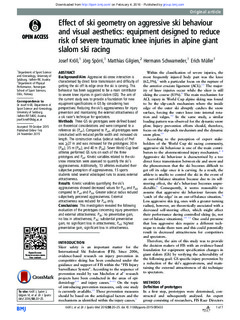| dc.contributor.author | Kröll, Josef | |
| dc.contributor.author | Spörri, Jörg | |
| dc.contributor.author | Gilgien, Matthias | |
| dc.contributor.author | Schwameder, Hermann | |
| dc.contributor.author | Müller, Erich | |
| dc.date.accessioned | 2016-04-06T08:12:29Z | |
| dc.date.available | 2016-04-06T08:12:29Z | |
| dc.date.issued | 2015-11-24 | |
| dc.identifier.citation | British Journal of Sports Medicine. 2015, 50, 20-25. | nb_NO |
| dc.identifier.uri | http://hdl.handle.net/11250/2384157 | |
| dc.description | This is an Open Access article distributed in accordance with the Creative Commons Attribution Non Commercial (CC BY-NC 4.0) license, which permits others to distribute, remix, adapt, build upon this work non-commercially, and license their derivative works on different terms, provided the original work is properly cited and the use is non-commercial. See: http://creativecommons.org/licenses/by-nc/4.0/ | nb_NO |
| dc.description.abstract | Background/Aim: Aggressive ski-snow interaction is characterised by direct force transmission and difficulty of getting the ski off its edge once the ski is carving. This behaviour has been suggested to be a main contributor to severe knee injuries in giant slalom (GS). The aim of the current study was to provide a foundation for new equipment specifications in GS by considering two perspectives: Reducing the ski's aggressiveness for injury prevention and maintaining the external attractiveness of a ski racer's technique for spectators.
Methods: Three GS ski prototypes were defined based on theoretical considerations and were compared to a reference ski (Pref). Compared to Pref, all prototypes were constructed with reduced profile width and increased ski length. The construction radius (sidecut radius) of Pref was ≥27 m and was increased for the prototypes: 30 m (P30), 35 m (P35), and 40 m (P40). Seven World Cup level athletes performed GS runs on each of the three prototypes and Pref. Kinetic variables related to the ski-snow interaction were assessed to quantify the ski's aggressiveness. Additionally, 13 athletes evaluated their subjective perception of aggressiveness. 15 sports students rated several videotaped runs to assess external attractiveness.
Results: Kinetic variables quantifying the ski's aggressiveness showed decreased values for P35 and P40 compared to Pref and P30. Greater sidecut radius reduced subjectively perceived aggressiveness. External attractiveness was reduced for P40 only.
Conclusions: This investigation revealed the following evaluation of the prototypes concerning injury prevention and external attractiveness: P30: no preventative gain, no loss in attractiveness; P35: substantial preventative gain, no significant loss in attractiveness; P40: highest preventative gain, significant loss in attractiveness. | nb_NO |
| dc.language.iso | eng | nb_NO |
| dc.publisher | BMJ Publishing Group | nb_NO |
| dc.title | Effect of ski geometry on aggressive ski behaviour and visual aesthetics: equipment designed to reduce risk of severe traumatic knee injuries in alpine giant slalom ski racing. | nb_NO |
| dc.type | Journal article | nb_NO |
| dc.type | Peer reviewed | nb_NO |
| dc.subject.nsi | VDP::Social science: 200 | nb_NO |
| dc.subject.nsi | VDP::Social science: 200::Social science in sports: 330 | nb_NO |
| dc.subject.nsi | VDP::Social science: 200::Social science in sports: 330::Other subjects within physical education: 339 | nb_NO |
| dc.source.journal | British Journal of Sports Medicine | nb_NO |
| dc.identifier.doi | 10.1136/bjsports-2015-095433 | |
| dc.description.localcode | Seksjon for fysisk prestasjonsevne / Department of Physical Performance | nb_NO |
